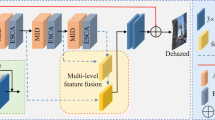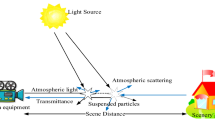Abstract
Haze appearing in natural scene images generally contains nonhomogeneous characteristics such as filaments, masses, and mist. The high-frequency part of hazy images contains variable background textures and haze shapes, whereas regions with mostly uniform distribution are dominated by low-frequency information. Although existing methods based on convolutional neural networks have achieved remarkable progress in single image dehazing, the intrinsic hazy image patterns have been neglected in most models. We propose a frequency division dehazing network to leverage prior knowledge characterizing hazy images. The proposed network processes shallow feature maps through high-, medium-, and low-frequency branches. This separation facilitates a flexible architecture, whose branch handling lower-frequency components is less redundant given its relatively simpler background and haze shapes. Then, by integrating knowledge extracted from all the network branches using feature fusion, the proposed network fully exploits the variety of frequency characteristics in hazy images and achieves 39.51 PSNR and 0.9931 SSIM on the RESIDE dataset. Experiments on both synthetic and real hazy images demonstrate the superiority of the proposed network over several existing state-of-the-art methods, demonstrating the effectiveness of exploiting prior knowledge in hazy images.













Similar content being viewed by others
Data availability
The datasets generated during and analyzed during the current study are available from the corresponding author on reasonable request.
References
Li Y, Chen Y, Wang N, Zhang Z (2019) Scale-aware trident networks for object detection. In: Proceedings of the IEEE/CVF international conference on computer vision (ICCV), pp 6054–6063
Roy AM, Bose R, Bhaduri J (2022) A fast accurate fine-grain object detection model based on yolov4 deep neural network. Neural Comput Appl 34(5):3895–3921
Yazdanbakhsh O, Dick S (2019) Multivariate time series classification using dilated convolutional neural network. arXiv preprint arXiv:1905.01697
Zhang Y, Wang S, Zhao H, Guo Z, Sun D (2021) Ct image classification based on convolutional neural network. Neural Comput Appl 33(14):8191–8200
Jiang T-X, Huang T-Z, Zhao X-L, Deng L-J, Wang Y (2018) Fastderain: a novel video rain streak removal method using directional gradient priors. IEEE Trans Image Process 28(4):2089–2102
Zhuang J-H, Luo Y, Zhao X-L, Jiang T-X (2021) Reconciling hand-crafted and self-supervised deep priors for video directional rain streaks removal. IEEE Signal Process Lett 2:589
Chen Z, Bi X, Zhang Y, Yue J, Wang H (2022) Lightweightderain: learning a lightweight multi-scale high-order feedback network for single image de-raining. Neural Comput Appl 34(7):5431–5448
Zhang D, Li P, Zhao L, Xu D, Lu D (2021) Texture compensation with multi-scale dilated residual blocks for image denoising. Neural Comput Appl 33(19):12957–12971
Qian Y, Jiang Z, He Y, Zhang S, Jiang S (2022) Multi-scale error feedback network for low-light image enhancement. Neural Comput Appl 5:1–17
McCartney EJ (1976) Optics of the atmosphere: scattering by molecules and particles, vol 421. Wiley, New York
Kopf J, Neubert B, Chen B, Cohen M, Cohen-Or D, Deussen O, Uyttendaele M, Lischinski D (2008) Deep photo: model-based photograph enhancement and viewing. ACM Trans Gr 27(5):1–10
Li Z, Tan P, Tan RT, Zou D, Zhiying ZS, Cheong L-F (2015) Simultaneous video defogging and stereo reconstruction. In: Proceedings of the IEEE/CVF conference on computer vision and pattern recognition (CVPR), pp 4988–4997
Narasimhan SG, Nayar SK (2002) Vision and the atmosphere. Int J Comput Vision 48(3):233–254
Oakley JP, Satherley BL (1998) Improving image quality in poor visibility conditions using a physical model for contrast degradation. IEEE Trans Image Process 7(2):167–179
Berman D, Treibitz T, Avidan S (2017) Air-light estimation using haze-lines. In: Proceedings of the IEEE international conference on computational photography (ICCP), pp 1–9. IEEE
Carr P, Hartley R (2009) Improved single image dehazing using geometry. In: Proceedings of the digital image computing: techniques and applications (DICTA), pp 103–110. IEEE
Dong X-M, Hu X-Y, Peng S-L, Wang D-C (2010) Single color image dehazing using sparse priors. In: Proceedings of the IEEE international conference on image processing (ICIP), pp 3593–3596. IEEE
He K, Sun J, Tang X (2010) Single image haze removal using dark channel prior. IEEE Trans Pattern Anal Mach Intell 33(12):2341–2353
Cai B, Xu X, Jia K, Qing C, Tao D (2016) Dehazenet: an end-to-end system for single image haze removal. IEEE Trans Image Process 25(11):5187–5198
Chen D, He M, Fan Q, Liao J, Zhang L, Hou D, Yuan L, Hua G (2019) Gated context aggregation network for image dehazing and deraining. In: Proceedings of the IEEE winter conference on applications of computer vision (WACV), pp 1375–1383. IEEE
Deng Q, Huang Z, Tsai C-C, Lin C-W (2020) Hardgan: A haze-aware representation distillation gan for single image dehazing. In: Proceedings of the European conference on computer vision (ECCV), pp 722–738. Springer
Dong J, Pan J (2020) Physics-based feature dehazing networks. In: Proceedings of the European conference on computer vision (ECCV), pp 188–204. Springer
Li B, Peng X, Wang Z, Xu J, Feng D (2017) Aod-net: all-in-one dehazing network. In: Proceedings of the IEEE/CVF international conference on computer vision (ICCV), pp 4770–4778
Qin X, Wang Z, Bai Y, Xie X, Jia H (2020) Ffa-net: feature fusion attention network for single image dehazing. In: Proceedings of the AAAI conference on artificial intelligence (AAAI), vol 34, pp 11908–11915
Campbell FW, Robson JG (1968) Application of fourier analysis to the visibility of gratings. J Physiol 197(3):412
Tarel J-P, Hautiere N (2009) Fast visibility restoration from a single color or gray level image. In: Proceedings of the IEEE/CVF international conference on computer vision (ICCV), pp 2201–2208. IEEE
Xiao C, Gan J (2012) Fast image dehazing using guided joint bilateral filter. Vis Comput 28(6):713–721
Kim J-H, Jang W-D, Sim J-Y, Kim C-S (2013) Optimized contrast enhancement for real-time image and video dehazing. J Vis Commun Image Represent 24(3):410–425
Zhu Q, Mai J, Shao L (2015) A fast single image haze removal algorithm using color attenuation prior. IEEE Trans Image Process 24(11):3522–3533
Hong S, Kim M, Kang MG (2021) Single image dehazing via atmospheric scattering model-based image fusion. Signal Process 178:107798
Ren W, Liu S, Zhang H, Pan J, Cao X, Yang M-H (2016) Single image dehazing via multi-scale convolutional neural networks. In: Proceedings of the European conference on computer vision (ECCV), pp 154–169. Springer
Li Y, Liu Y, Yan Q, Zhang K (2020) Deep dehazing network with latent ensembling architecture and adversarial learning. IEEE Trans Image Process 30:1354–1368
Sun H, Zhang Y, Chen P, Dan Z, Sun S, Wan J, Li W (2021) Scale-free heterogeneous cyclegan for defogging from a single image for autonomous driving in fog. Neural Comput Appl 3:1–15
Metwaly K, Li X, Guo T, Monga V (2020) Nonlocal channel attention for nonhomogeneous image dehazing. In: Proceedings of the IEEE/CVF conference on computer vision and pattern recognition workshops (CVPRW), pp 452–453
Yang D, Sun J (2018) Proximal dehaze-net: a prior learning-based deep network for single image dehazing. In: Proceedings of the European conference on computer vision (ECCV), pp 702–717
Chen Z, Wang Y, Yang Y, Liu D (2021) Psd: Principled synthetic-to-real dehazing guided by physical priors. In: Proceedings of the IEEE/CVF conference on computer vision and pattern recognition (CVPR), pp 7180–7189
Wu H, Qu Y, Lin S, Zhou J, Qiao R, Zhang Z, Xie Y, Ma L (2021) Contrastive learning for compact single image dehazing. In: Proceedings of the IEEE/CVF conference on computer vision and pattern recognition (CVPR), pp 10551–10560
Singh V, Ramnath K, Arunachalam S, Mittal A (2020) Going much wider with deep networks for image super-resolution. In: Proceedings of the IEEE/CVF winter conference on applications of computer vision (WACV), pp 2343–2354
Fang F, Li J, Zeng T (2020) Soft-edge assisted network for single image super-resolution. IEEE Trans Image Process 29:4656–4668
Wang C, Shen H-Z, Fan F, Shao M-W, Yang C-S, Luo J-C, Deng L-J (2021) Eaa-net: a novel edge assisted attention network for single image dehazing. Knowl-Based Syst 5:107279
Jiang Y, Zhang W, Fu K, Zhao Q (2022) Meanet: multi-modal edge-aware network for light field salient object detection. Neurocomputing 491:78–90
Fu X, Huang J, Ding X, Liao Y, Paisley J (2017) Clearing the skies: a deep network architecture for single-image rain removal. IEEE Trans Image Process 26(6):2944–2956
Fritsche M, Gu S, Timofte R (2019) Frequency separation for real-world super-resolution. In: Proceedings of the IEEE/CVF international conference on computer vision workshop (ICCVW), pp 3599–3608. IEEE
Dong Y, Liu Y, Zhang H, Chen S, Qiao Y (2020) Fd-gan: Generative adversarial networks with fusion-discriminator for single image dehazing. In: Proceedings of the AAAI conference on artificial intelligence (AAAI), vol 34, pp 10729–10736
Yoon K-J, Shyam P, Kim K-S (2021) Towards domain invariant single image dehazing. In: Proceedings of the AAAI conference on aritificial intelligence (AAAI). Association for the Advancement of Artificial Intelligence
Chen Y, Fan H, Xu B, Yan Z, Kalantidis Y, Rohrbach M, Yan S, Feng J (2019) Drop an octave: reducing spatial redundancy in convolutional neural networks with octave convolution. In: Proceedings of the IEEE/CVF international conference on computer vision (ICCV), pp 3435–3444
Pang Y, Li X, Jin X, Wu Y, Liu J, Liu S, Chen Z (2020) Fan: frequency aggregation network for real image super-resolution. In: Proceedings of the European conference on computer vision (ECCV), pp 468–483 . Springer
Li X, Jin X, Yu T, Pang Y, Sun S, Zhang Z, Chen Z (2020) Learning omni-frequency region-adaptive representations for real image super-resolution. arXiv preprint arXiv:2012.06131
Iizuka S, Simo-Serra E, Ishikawa H (2017) Globally and locally consistent image completion. ACM Trans Gr 36(4):1–14
Yu F, Koltun V (2015) Multi-scale context aggregation by dilated convolutions. arXiv preprint arXiv:1511.07122
Johnson J, Alahi A, Fei-Fei L (2016) Perceptual losses for real-time style transfer and super-resolution. In: Proceedings of the European conference on computer vision (ECCV), pp 694–711. Springer
Simonyan K, Zisserman A (2014) Very deep convolutional networks for large-scale image recognition. arXiv preprint arXiv:1409.1556
Li B, Ren W, Fu D, Tao D, Feng D, Zeng W, Wang Z (2019) Benchmarking single-image dehazing and beyond. IEEE Trans Image Process 28(1):492–505
Ancuti CO, Ancuti C, Timofte R (2020) Nh-haze: An image dehazing benchmark with non-homogeneous hazy and haze-free images. In: Proceedings of the IEEE/CVF conference on computer vision and pattern recognition workshops (CVPRW), pp 444–445
Ancuti CO, Ancuti C, Sbert M, Timofte R (2019) Dense-haze: a benchmark for image dehazing with dense-haze and haze-free images. In: Proceedings of the IEEE international conference on image processing (ICIP), pp 1014–1018. IEEE
He T, Zhang Z, Zhang H, Zhang Z, Xie J, Li M (2019) Bag of tricks for image classification with convolutional neural networks. In: Proceedings of the IEEE/CVF conference on computer vision and pattern recognition (CVPR), pp 558–567
Liu X, Ma Y, Shi Z, Chen J (2019) Griddehazenet: attention-based multi-scale network for image dehazing. In: Proceedings of the IEEE/CVF international conference on computer vision (ICCV), pp 7314–7323
Bai H, Pan J, Xiang X, Tang J (2022) Self-guided image dehazing using progressive feature fusion. IEEE Trans Image Process 31:1217–1229
Funding
This work is supported by the Basic Public Welfare Research Program of Zhejiang Province (LGG22F020036), National Natural Science Foundation of China (12001005), and Natural Science Foundation of Anhui Province (2008085QF286).
Author information
Authors and Affiliations
Corresponding author
Ethics declarations
Conflict of interest
There are no conflicts of interest to declare.
Additional information
Publisher's Note
Springer Nature remains neutral with regard to jurisdictional claims in published maps and institutional affiliations.
Rights and permissions
Springer Nature or its licensor (e.g. a society or other partner) holds exclusive rights to this article under a publishing agreement with the author(s) or other rightsholder(s); author self-archiving of the accepted manuscript version of this article is solely governed by the terms of such publishing agreement and applicable law.
About this article
Cite this article
Shen, H., Wang, C., Deng, L. et al. FDDN: frequency-guided network for single image dehazing. Neural Comput & Applic 35, 18309–18324 (2023). https://doi.org/10.1007/s00521-023-08637-3
Received:
Accepted:
Published:
Issue Date:
DOI: https://doi.org/10.1007/s00521-023-08637-3




